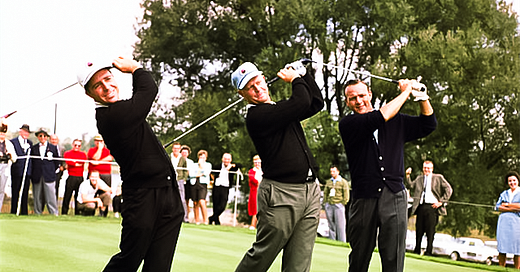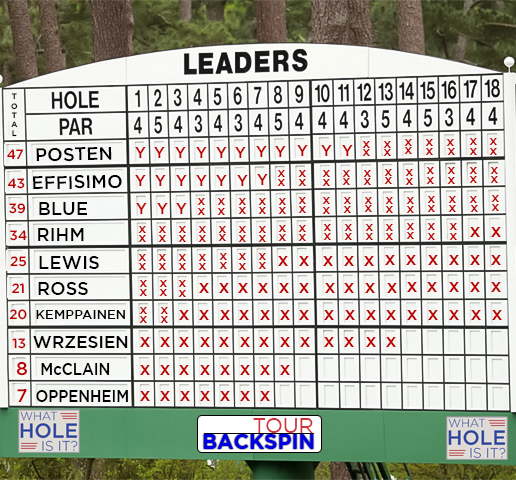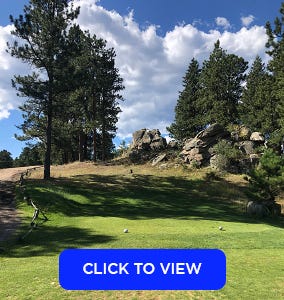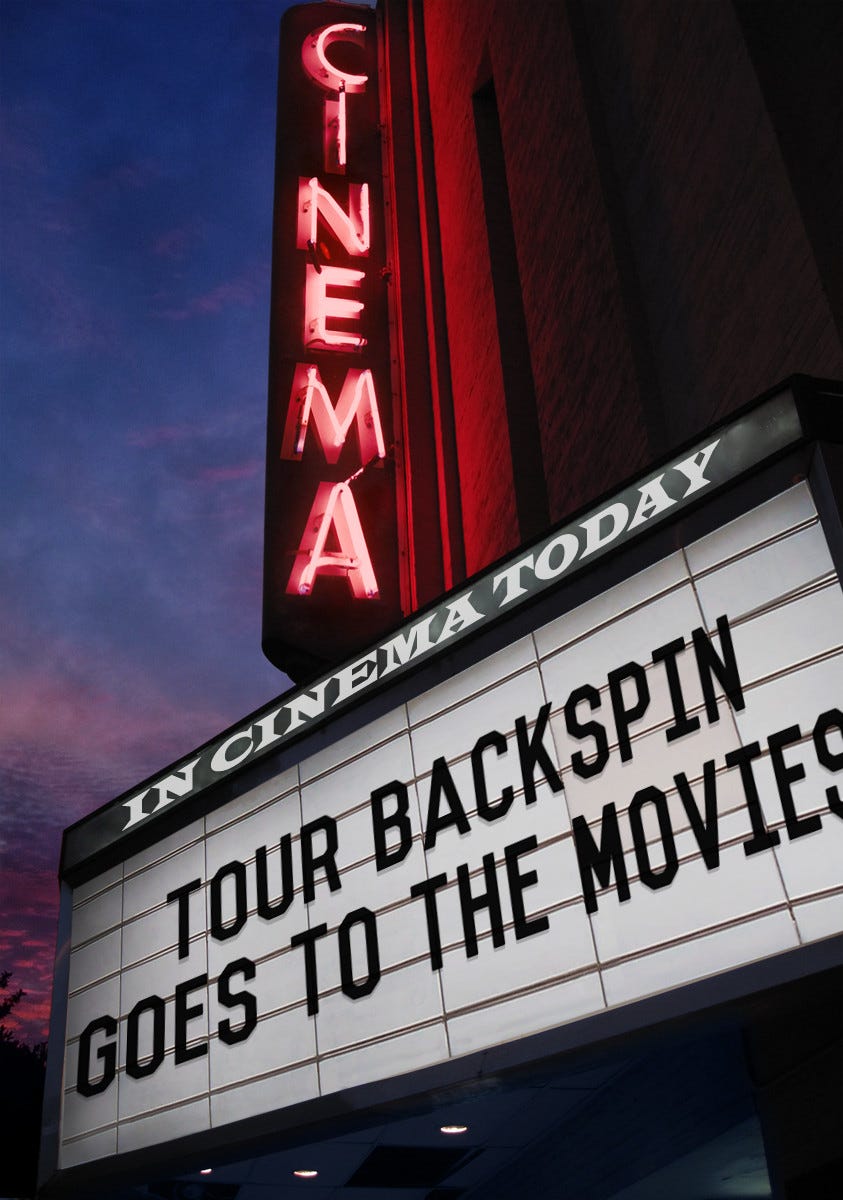The Birth of Televised Exhibitions
The 1962 World Series of Golf ushers in the era of televised golf exhibitions

All aboard for the Tour Backspin journey through the past as we spin back to 1962 and the first World Series of Golf that featured Gary Player, winner of the PGA Championship, Jack Nicklaus, winner of the U.S. Open, and Arnold Palmer the winner of the Masters and Open Championship. This televised exhibition awarded the winner $50,000 in an era where first-place checks at most PGA events were in the $5,000 to $10,000 range. This exhibition ushered in an era of televised golf exhibition matches including Shell’s Wonderful World of Golf, The CBS Golf Classic, and The Big Three Golf. Scroll down to learn more.
We are so grateful for our readers and want to wish each and every one of you joyful tidings this holiday season.
Give you golf buddies the golfing gift that will be opened every week. ‘Tis the season to spread joy, and what better way than to gift a subscription to your squad.
There was another exhibition on the PGA TOUR, a mixed event with stars of the LPGA joining the boys for a team event at the Grant Thornton Invitational. The more important action was at the Korn Ferry Q-School where five (plus ties) PGA TOUR cards were up for grabs. Scroll down for my recap and the Clips You Might Have Missed from the week.
The Tour Backspin Poll features a question for you to ponder and let us know what you think. This week’s Music Clip has The Contours performing “Do You Love Me?” live in 1962. Tour Backspin Goes to The Movies, has a scene from the 1962 film “Mr. Magoo’s Christmas Carol” starring Jim Bacchus. Scroll down to listen and watch.
We again visit the Carl Welty library for this week’s Swing Like a Pro. Check out Jack Nicklaus and his swing after hip replacement. Take a shot at the WHAT HOLE IS IT? this week and you could win a goody bundle of golf swag. We’ve got some links for you in the Check it Out section and an ad from 1962 that features gorgous leather bags from MacGregor when they were owned by Brunswick Sports. I’m sure these made a great Christmas gift back in the day before cart bags and stand bags. Have a look in this week’s Vintage Ad. Scroll down to view.
The Tour Backspin Poll
Last week, in the Tour Backspin Poll, we asked you if you thought the PGA Creator Council would enhance fan engagement. There were 89% of respondents who felt the concept was a bit contrived and would not enhance fan engagement, while 11% thought it was going to help flagging ratings by bringing something new to the table. Let us know how you feel about this week’s question.
Did you watch The Showdown? Did you love it, or hate it? Let us know in this week’s Tour Backspin Poll.
We’re playing World Series of Golf Trivia in this week’s Tour Backspin Quiz. Scroll down to play.
Did you miss a previous newsletter? You can view it HERE. Help us grow Tour Backspin! Please forward this email to a friend. Was this newsletter forwarded to you? You can sign up HERE.
Okay, we're on the tee, let's get going.
Enjoy!
Larry Baush
The “Big Three” and the First World Series of Golf
Live sports broadcasting was coming into its own and building momentum in 1962, and golf was at the forefront as networks came to the realization the potential of the sport on the small screen. NBC capitalized on this potential with a made-for-television event known as the World Series of Golf that would pit the winners of the year’s major championships against each other in a 36-hole, two-day tournament.
Arnold Palmer won the 1962 Masters and Open Championships, Jack Nicklaus won the U.S. Open, and Gary Player won the PGA Championship. These three players would face off in the inaugural World Series of Golf.
“An exhibition and not a legitimate tournament.”
The Firestone Country Club in Akron, OH, would play host to the event on the weekend of September 8th and 9th, just a month removed from playing host to the American Golf Classic won by Palmer. The World Series of Golf would be played opposite of the Denver Open Invitational at the Denver Country Club on the regular PGA circuit, much to the consternation of the Denver event organizers.
Noble Chalfant, the head honcho of the Denver Open was demoralized that he would not have the three biggest names in golf in his field. He threatened legal action against the PGA of America and labeled the World Series of Golf as “an exhibition and not a legitimate tournament.”
NBC went all-in for the broadcast employing an army of 50 people. The crew included commentators, engineers, technicians, and production personnel. Nine cameras would televise the live action in full color and the broadcast would begin on the 13th hole both Saturday and Sunday.
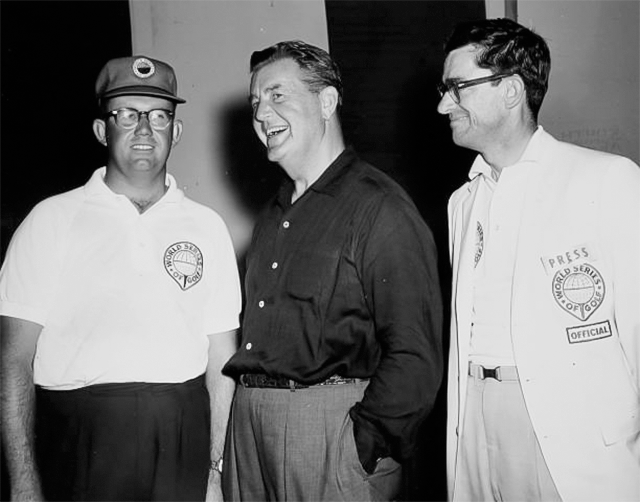
NBC erected eight towers, ranging in height from 15 to 35 feet, along the final six holes and announcers Bud Palmer, Chick Hearn, Jack Drees, and Bob Rosburg, who for the first time, would report from the ground giving the television audience a close-up view of shots faced by the players. Rosburg would go on to continue this role full-time in 1974 joining ABC for their golf telecasts.
“It was around this time point that these three golfers began to enjoy total domination.”
“For one thing, this is the biggest color remote broadcast ever attempted,” producer Perry N. Smith told reporters previewing the event.
Interest was sky high to watch the competition between what the press was just beginning to call “The Big Three” of Palmer, Nicklaus and Player. The designation was promoted by Mark McCormack, who represented all three players.
“The World Series of Golf in 1962 was a big deal,” said Alastair Johnston of IMG, the marketing giant that McCormack founded. “It was around this time point that these three golfers began to enjoy total domination.”
The three players met for their first practice round at Firestone on Thursday which attracted a large gallery. The three players enjoyed a relaxed round while they joked with each other, and the gallery.
Despite a double-bogey on the 465-yard, par-4, 4th hole, Palmer shot the low round with a 70. Player shot a 74, and Nicklaus, who sprayed his tee shots all over the course, shot a 76.
Friday’s practice round on the 7,165-yard Firestone layout featured much better shotmaking and lower scores than the Thursday practice round. The three players went on a birdie binge with Nicklaus recording seven threes in one eight-hole stretch and recorded a 66, a score matched by Player. Their 66s were just one shot off the course record. Palmer birdied five holes on the back nine to record a 68.
The stage was set for the lucrative exhibition to start.
The course record, which barely survived Friday’s practice round, was matched in the first round on Saturday as Palmer went 31-34—65. He took a one stroke lead over Nicklaus as Player was four shots off the lead. Palmer tied the course record set by Don Fairfield in the 1961 American Golf Classic and was tied by Rosburg in the 1962 event.
Palmer only needed 25 putts in his record tieing round and the fireworks exploded before the players reached the 13th hole where the television coverage began. Palmer birdied the first three holes, but it only gained him a one-shot lead over Nicklaus. The players combined for ten birdies before reaching the 13th hole, and then could do no better than three sub-par scores the rest of the way in. Palmer recorded his only bogey in the glare of the television cameras.
Palmer excited the gallery on the course with his theatrics on the 4th hole when he hooked his tee shot into a grove of trees at the edge of a huge gully. He hit his second shot with a 3-wood employing a baseball-style swing that the sidehill lie required. He skied his next shot into deep rough behind more trees, then lofted his third shot onto the green and made the putt for a par that save him from losing ground to either Player or Nicklaus who both parred the hole in a more usual way hitting the green in regulation.

Palmer again displayed his derring-do on the final hole when he drove into the trees right of the fairway. He spotted a small opening, drilled an iron shot through it to the green within eight feet of the hole and two-putted for his par.
Nicklaus finished with a 66 while Player came in with a 69.
The gallery on the course numbered 5,500 and many were recruits into “Arnie’s Army” who cheered his every move. Many more golf fans watched on television and would tune in again on Sunday when the broadcast would start at 3:30 (EST).
Sunday was Palmer’s 33rd birthday and he hoped to celebrate in style by winning the World Series of Golf, but as spectacular as Saturday’s start was with birdies on the first three holes, Sunday’s final round was just as dismal. After Saturday’s round when his putter was blazing hot, Palmer began Sunday’s round with two straight three-putts and then hit a shot into a lake on the third hole. The start surrendered the lead to Nicklaus who never looked back on his way to a 69 and a two-day total of 135.
“But I wondered even after I won the U.S. Open whether I belonged up there with the ‘king’—that’s Palmer—and all the rest. I guess I do now.”
Palmer finished at 139 after shooting a 74 on Sunday tied with Player who added a 70 to his first-round 69. Nicklaus won the $50,000 first-place prize, while Palmer and Player won $12,500 each.
The win proved to Nicklaus that he belonged amongst the highest ranked players on the PGA.
“I’ve been doing well,” the burly Nicklaus said to reporters including Leo H. Petersen, the Sports Editor for the United Press International. “But I wondered even after I won the U.S. Open whether I belonged up there with the ‘king’—that’s Palmer—and all the rest. I guess I do now.”
Nicklaus clinched the victory with two birdies, at the 11th and 12th holes, one hole short of the start of the television coverage of the homestretch. Television viewers were rewarded when Nicklaus birdied the final hole.
The two-day television event generated a lot of attention and excitement relegating the Denver Open, which was not televised, to the back pages of the sports sections in the national press. The early adaptation of color, expanding the usual number of televised finishing holes from three to six, and the introduction of Bob Rosburg as a knowledgeable on-course commentator, all paved the way for golf broadcasts in the future. It also led to a proliferation of televised golf matches including Shell’s Wonderful World of Golf, The Big Three Challenge, The CBS Golf Classic, and later, the International Pro-Celebrity Golf matches.
This era of televised exhibition golf matches helped usher in the exciting new world of sports broadcasting, and the 1962 World Series of Golf broadcast played a major role in the new technology.
BONUS STORY
The three players managed by Mark McCormick, Arnold Palmer, Jack Nicklaus, and Gary Player, made up the field of the 1962 World Series of Golf televised exhibition. The competition proved to be so popular with golf fans that it gave McCormick an idea to build and expand on the group that he was promoting as “The Big Three.”
“The intensity of our competition, as well as the distinct differences in our personalities, created tremendous natural drama and a fan interest in the professional game that had never been seen before.”
McCormick negotiated a deal with NBC for a series of televised matches that was dubbed “Big Three Golf.” The eight-part series featured the three players competing against each other over some of the most famous courses in the world including Los Angeles Country Club, St. Andrews, Firestone Country Club, and Carnoustie. The matches debuted in the spring of 1965.
“Our rivalry happened at a time when golf was just beginning to take deep root in the broader American sports psyche,” Arnold Palmer explained years later. “The intensity of our competition, as well as the distinct differences in our personalities, created tremendous natural drama and a fan interest in the professional game that had never been seen before.”
Television helped build the popularity of Palmer, Nicklaus, and Player, and they, in return, helped build the popularity of professional golf and televised exhibition matches. As proven by the popularity of recent televised exhibition matches including Tuesday’s The Showdown, McCormick’s idea has endured to this day.
WHAT HOLE IS IT?
Congratulations to Doug Posten for winning the WHAT HOLE IS IT? contest last week by correctly identifying #16 at Dye’s Valley, TPC Sawgrass in Ponte Vedra Beach, FL. Doug beat out two other correct answers in the drawing and we’ve got a prize pack of golf swag on the way to him.
We understand if a premium subscription isn’t in the budget, and we’re happy to have you here however you’ve arrived. You can sign up for a free subscription so you’ll never miss the newsletter. It will arrive in your inbox every Thursday. Paid subscribers help fund the work we do here at Tour Backspin.
We told you about getting our hands on a treasure trove of film that we are cleaning up and digitizing for the Tony Lema documentary. Some great footage of Tony in action and even home movies. The work is paying off with good results. We’ve got a new sample coming next week. Check it out (clicking on link will open this post on the web, scroll down to video player).
PGA TOUR Wrap-Up | Korn Ferry Tour Q-School

Lanto Griffin led a graduating class of six in the Korn Ferry Q-School who earned their playing cards on the PGA TOUR. He fired a final round 63 to capture the medalist honors at Dye’s Valley Course at TPC Sawgrass in Ponte Vedra Beach, FL. After two poor years on the PGA TOUR, Griffin didn’t have any status on even the Korn Ferry Tour, but winning his card puts him right back on the tour.
Five other players qualified for their tour cards including Hayden Buckley, a two-year PGA Tour veteran, Takumi Kanaya of Japan, Alejandro Tosti, a rookie on the 2024 PGA TOUR, Will Chandler who will be a tour rookie in 2025, Matthew Riedel, a former standout at Vanderbilt University who played on the Korn Ferry Tour this past year.
Read more about the final round HERE.
The round 4 highlights:
Clips You Might Have Missed
Great shot, right when he needed it.
It got windy in round two.
Rory for eagle during The Showdown.
Tour Backspin Quiz | World Series of Golf Trivia
What was the last year that the World Series of Golf was played as an unoffical four-man invitational exhibition?
Scroll down for answer
Swing Like a Pro
From the Carl Welty library, Jack Nicklaus at the 1998 U.S. Open.
Blind Shot
Click for something fun. 👀
The Skins Game is coming back in 2025 and James Colgan of Golf.com has the details.
Tour Backspin Music Clip
The Contours perform “Do You Love Me)” live 1962.
Tour Backspin Quiz Answer:
The last year that the World Series of Golf was played as a four-man, unofficial invitational, was 1975 when Tom Watson beat Jack Nicklaus, Tom Weiskopf, and Lou Graham.
Thank you for reading this far, I know your time is valuable and choosing to spend some of it on what I’ve created is gratifying. If you want to help support the work we’re doing, please consider upgrading. It’s just $36 a year and you’ll be helping to tell the stories from one of golf’s golden ages.
Vintage Ad
Final Thoughts
Do you love me, now that I can dance? Watch me now!
Most of this week’s Tour Backspin was done on an airplane on the way to Maui. That’s why it is a little light this week. We’ll update you next week on our golfing adventures while there. Until then, Mele Kalikimaka!


